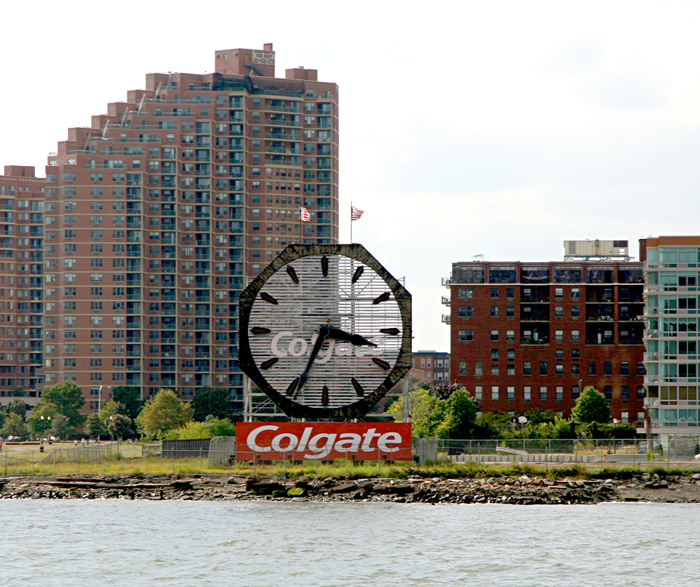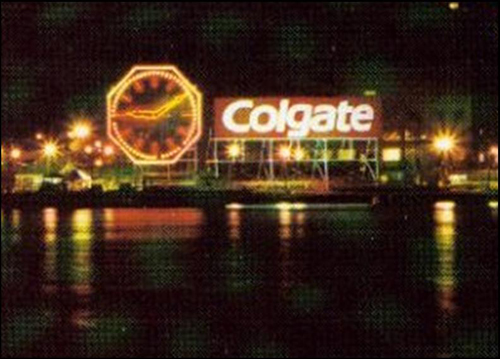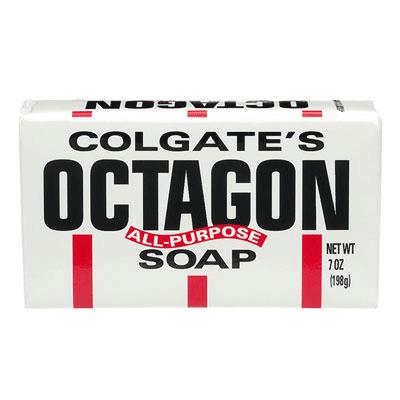This clock had a similar but smaller predecessor that was erected in 1906 to commemorate the centennial of Colgate. Its single face was 38 feet in diameter, not quite as large as the current Allen-Bradley clock faces. When the larger clock was installed in 1924, the original was moved to Jeffersonville, Indiana, where it still helps citizens keep time.
The frames that hold round faces on both Colgate clocks are octagons, a shape that was inspired by a popular product Colgate first produced in the late 1800s and still manufactures today called Octagon Soap. A company spokesperson checked but was unable to determine why the soap has the shape of an elongated octagon.
Possibly Lynde or Harry, while visiting Manhattan, saw the first Colgate clock in the years leading up to their choosing the octagon. Moreover, once they were using the octagon in their trademark to identify the company and its products, it seems probable that one or both would have heard about the octagonal Colgate clock and perhaps seen it or pictures of it. It certainly could have been a factor in Harry’s decision to install the first Allen-Bradley clock in the early fifties. As the night photo shows, the Colgate clock also has lighted hands and hash marks.
Although nothing popped up in my research that indicated the value of the Allen-Bradley clocks in terms of community goodwill and publicity, it had to have been substantial for the company to devote large amounts of money to designing, building, and maintaining them. Today the octagon is so tightly linked with the company and its products that when I was researching this article, almost everyone I talked with, regardless of location, recognized the octagon as the trademark of Allen-Bradley and Rockwell Automation.
How it came to be is a question that I was not able to answer with airtight certainty. It is still an open case. Naturally, if you have any idea why the octagon was chosen or have evidence to support my primary theory—that it was inspired by the schoolhouse clock—or any of the other possibilities, please e-mail ted@tswrites.com.
Before leaving you to other mysteries, it occurred to me that you might be wondering why the schoolhouse clock itself featured an octagonal surround. I explored this but again, sadly, didn’t find a positive explanation. I did discover that its most likely progenitor was a late 18th-century timekeeper known as the Act of Parliament Clock, sometimes called the Tavern Clock. Legend says it was first produced by English clock makers as a response to a tax levied on clocks by the English Parliament in 1797. The tax dampened sales to citizens so clock makers created a device taverns could purchase to draw in patrons who wanted to know the time. Other sources, however, say clocks of this kind were around before the tax.
Even if the Act of Parliament Clock was the certain predecessor, it doesn’t explain the octagon.
Because some of the octagon clocks I have encountered—especially the schoolhouse type—are 8-day, it seemed possible that the shape was chosen to match the wind period. Various clock makers and specialists, however, told me they think this unlikely because many clocks were 8-day and featured surrounds of various shapes.
Instead, they say its origin is probably fairly mundane, strictly a matter of style, manufacturability, and marketing. The octagonal shape is simply more exotic and perhaps more appealing than a plain square or rectangle and, in the years before modern manufacturing, far easier to cut from wood stock—even with all the mitered corners—than a perfect circle.

Act of Parliament Clock, 1797.
Photo by Bunratty Castle, Gort Furniture Trust.
Used with permission.

Colgate clock, New Jersey.
Photo by Brian Dube
http://newyorkdailyphoto.blogspot.com/2007/10/lonely-clock.html
Used with permission

Photo by Colgate-Palmolive Company. Used with permission.

Octagon Soap
Octagon soap was first made in the late 1800s.
Photo by Colgate-Palmolive Company. Used with permission.